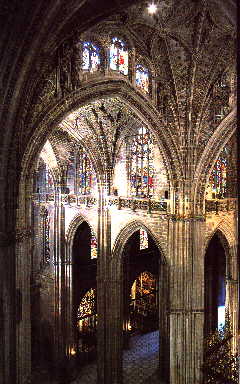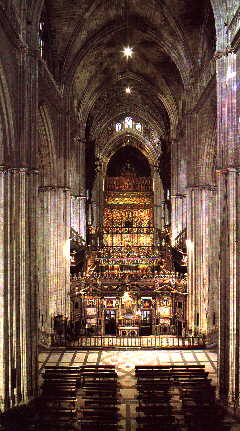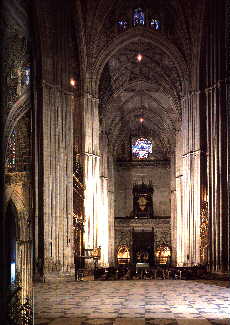Seville Cathedral: Building the Cathedral
 Interior of the Church
Interior of the Church |
When Fernando III reconquered Seville in 1248 the Almohad mosque was slowly turned into a Chistian cathedral, a process which did nor require any change in its architectural structure. The building was simply adapted to Chistian worship by changing the direction of the nave and aisles, placing the presbytery of the church in the east and the end in the west. In this fashion the former mosque was used as a Christian church for a century and a half until 1401 when the Cathedral chapter decided to build a new church. This decision was prompted mainly by the fact that the Almohad mosque was in bad repair because it had suffered greatly during an earthquake, which had devastated the city in 1356, and was in a rather dilapidated state.
Work began in 1403 with the idea of building a magnificent edifice since at that time the financial situation of the chapter was prosperous. It is not known whether
the words below, traditionally ascribed to one of the canons of the Cathedral, were really spoken when the agreement to build the new church had been reached: "Let us build such a large church that all those who see it finished will think we are mad".
Auch words are not an exaggeration since the Cathedral of Seville is one of the largest churches in Chistendom, only surpassed by Saint Peter´s in the Vatican and by Saint Paul´s in London.
|
Unfortunately building the new cathedral meant demolishing the mosque with the exception of the minaret, which in the course of time was to become the popular Giralda as it was used as a belfry. It took a century and a long succession of architects to build the church, which was in the gothic style, the main artistic trend in Spain during the 15C.
It is not certain which master builder began the works or who the author of the project was. Alonso Martínez has been mentioned as the builder who may have taken the first steps since
as such he was in charge of the Cathedral in the years immediately before the beginning of its construction. In the course of the years a succession of different architects were in charge of the edifice, among them Pedro García, Ysambret, Carlín, Juan López, Norman, Juan de Hoces, Simón de Colonia and Alonso Rodríguez, who finished the works in 1506.
|
 Interior of the Church
Interior of the Church
|
Later the Cathedral was in the hands of Juan Gil de Hontañon, who committed himself to building the lantern of the crossing which had collapsed in 1511. It took him until 1519 to finish the task.
When the maun building had finished a sacristy, chapter-house, offices for bookkeeping and other rooms were added with the result that
the building activity continued thoughout the 16C. The artists who took part in it included Diego de Riaño, Martín de Gainza, Hernán Ruiz II and Asensio de Maeda, as will be seen when reference is made to the works of art produced by each of these masters. Further works took place in the 17C, 18C and 19C when the lantern was roofed, only to cave in again in 1888, and the portals of the transepts were built.
|
 Interior of the Church
Interior of the Church
|
|
|


